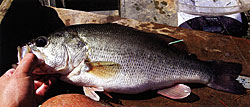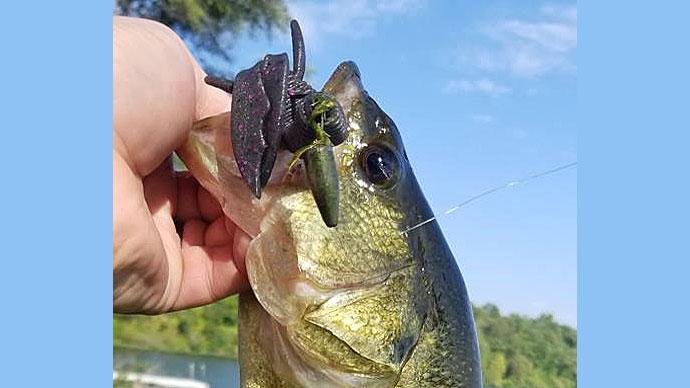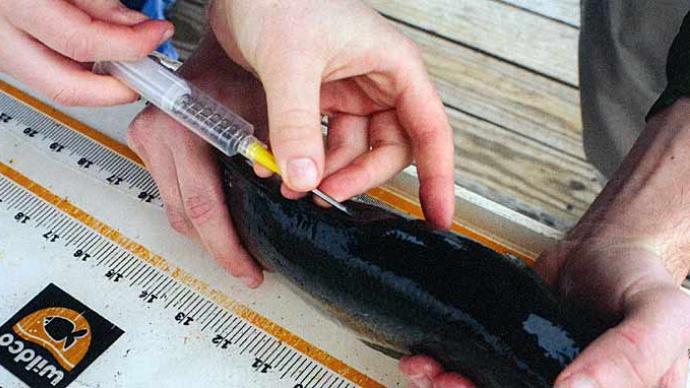
Our fisheries team is often asked about the value of tagging bass. Fisheries biologists use this tool to track individual fish within a population. If we can capture a fish, weigh and measure it, write the date and even where the fish was collected within the lake, we can gain an idea of how well that fish is thriving (or not) when we see it again later.
Tagging bass is not only an important tool for fisheries biologists, it is can also be an important tool for you. Tagging bass is quick and easy, after tagging a few fish to familiarize yourself with the process.
And, it is just plain fun to catch a fish you have previously caught and especially cool for friends and family.
Tagged fish can supply important information for catch records and give a general idea of your census of fish and even provide an idea of migration habits of those individuals. Tags are popularly used to examine growth rates over time since most types can be read for more than five years. Also, throughout the year, if you happen to catch tagged fish, you can monitor growth rates of tagged bass as you get a bass population back in balance through harvesting, or stocking more forage such as bluegill, shad, or tilapia, etc. We have many tagging records from clients indicating growth (or lack thereof) of bass we had tagged in years past. The following is some interesting data we collected in 2009 from two different lakes.
First is an 80 acre lake at Big Sandy Plantation located in Macon, Georgia. This lake has high tannin contents (acidic) and the upper end of the lake resembles a swamp, while the lower end looks more like a traditional lake. Being that a major tributary (Big Sandy Creek) runs through the lake, the species diversity is quite high. This lake contains largemouth bass, bluegill, shellcracker, bowfin, flier, crappie, lake chubsucker, longnose and shortnose gar, golden shiners and several creek minnow species. A good number of bass have been tagged in this lake by fishermen, but, in 2009, a tagged bass was caught for the third time, giving us some important data. This bass was tagged in May, 2008 and measured 17-1/2", 2.7 lbs., and had a relative weight (Wr) of 81%. This bass was then caught in July 2008 at 17-1/2", 2.1 lbs., and 69% Wr and in November 2009 at 21-1/2", 5.4 lbs., and 90% Wr. For a lake of this nature, this is an excellent growth rate.
What does this bass tell us? Well, it appears the bass lost weight over the summer of 2008. It was noted in May it was already spawned out, so the presence of eggs was not the loss of weight. The bass appears to have done quite well the next year and a half after this July capture. It gained 4 inches and 3.3 lbs in a year and 4 months. Also notice the 90% Wr. This tells us that, at some point, it was actually healthier or it could not have made it to 21-1/2" otherwise.
The second lake should be familiar to Pond Boss readers. It is a 31 acre lake at Four Holes Farm (July 2008 Pond Boss) in Orangeburg, SC. This lake is fertilized and has a good population of threadfin shad, bluegill and shellcracker, along with hybrid striped bass and tilapia which are stocked each spring. Gizzard shad were also stocked in the spring of 2009. The following bass, caught in Fall 2009, were all previously tagged. Fish #98 was tagged in April 2008 at 16", 2-1/2 lbs., and 111%. This fish was caught in September 2008 at 17-1/2", 3.1 lbs., 104% and in November 2009 at 20-1/2", 4.0 lbs., and 81%. Fish #165 was tagged in April 2009 at 15-1/2", 1.8 tbs., 90% and caught in November 2009 at 16", 1.7 lbs., and 76%. Fish # 149 was tagged in September 2008 at 15-1/2", 2.0 lbs., 100% and the caught in April 2009 at 16", 2.5 lbs, 111% and in November 2009 at 16", 2.1 lbs., 95%.
This is a better data set and indicates what I suspect is also going on at Big Sandy Plantation. These bass lose weight over the hot summer months. Look at the data closely. In every case the bass are less healthy in the fall versus the spring. If looking at a gravid female then this is predictable but the bass tagged in April had already spawned. It appears the bulk of weight gain takes place during the cooler months of the year. I do not think these bass grow when water temperature falls below 50 degrees but there is good growth into December and beginning sometime in February. At Big Sandy, I think bass are doing quite well in spite of being in poor shape in July of 2008. In many cases, we might have had clients remove a bass at 69% Wr. The bass from Four Holes Farm indicates this same thought process. This is interesting information that would not have been gained without the use of tagging. We would have eliminated bass that actually could have grown larger.

This tells us more than just this interesting factoid ... in our climate bass may grow better in the winter than in the summer; it tells me we could be getting even more information with the use of more numbered tags. Imagine, with larger data sets and monthly fishing, you could really track some growth rates. In this case, maybe we need to add another forage fish to help bass grow in the summer.
Another good use for tagged bass is to track a comparable census of your fish. For example, say you tag 25 fish. Then, over time, you catch 100 fish and five of them have tags. You can roughly estimate that 5% of your fish are tagged. So, you likely have as many as 500 catchable bass. Comparing growth rates of tagged bass with the Wr (relative weight) of all bass caught can give you a good idea as to what your selective harvest program should be.
The tags do not necessarily apply just to bass. You could use them to gather data on most any species of fish in your ponds. Track the growth of those bluegill hanging out in front of the feeder to predict when they will reach two pounds. Do not be intimidated using the tagging guns. There seems to be some who fear they will injure the fish. The instructions for use are simple and we have a tutorial on YouTube at https://www.youtube.com/watch?v=EVhpPSJgSYQ.
Each tagging system has good instructions and directions how to use them. Be sure to understand what you are trying to do before taking on a tagging program.
I know after this eye opening information we will begin tagging even more bass and encourage the pond owners to do the same. However, remember the saying "garbage in equals garbage out". When using the tags for data info, take accurate weights and lengths. We have a pond kit that includes accurate scales, measuring boards and data sheets, etc. and the guns and tags are available with other Pond Boss advertisers. Start using tags to learn more about your ponds ... it should be one of the best tools in your pond management arsenal.
| Some Tagging Kit Sources |
| Aquatic Ecosystems sells tagging guns and tags. Guns with 100 tags are less than $ 100. Visit them at www.aquaticeco.com Call Matt Rayl at (407)886-3939.Greg Grimes' Aquatic Management Services at www.lakework.com sells a Floy tagging kit for $130.00. Call them at (770)735-3523 or email at greg@lakework.com.Herman Bros. Pond Management sells a kit for $80.00. See them at www.hbpondmanagement.com or call (309)303-5691. |
Reprinted with permission from Pond Boss Magazine


